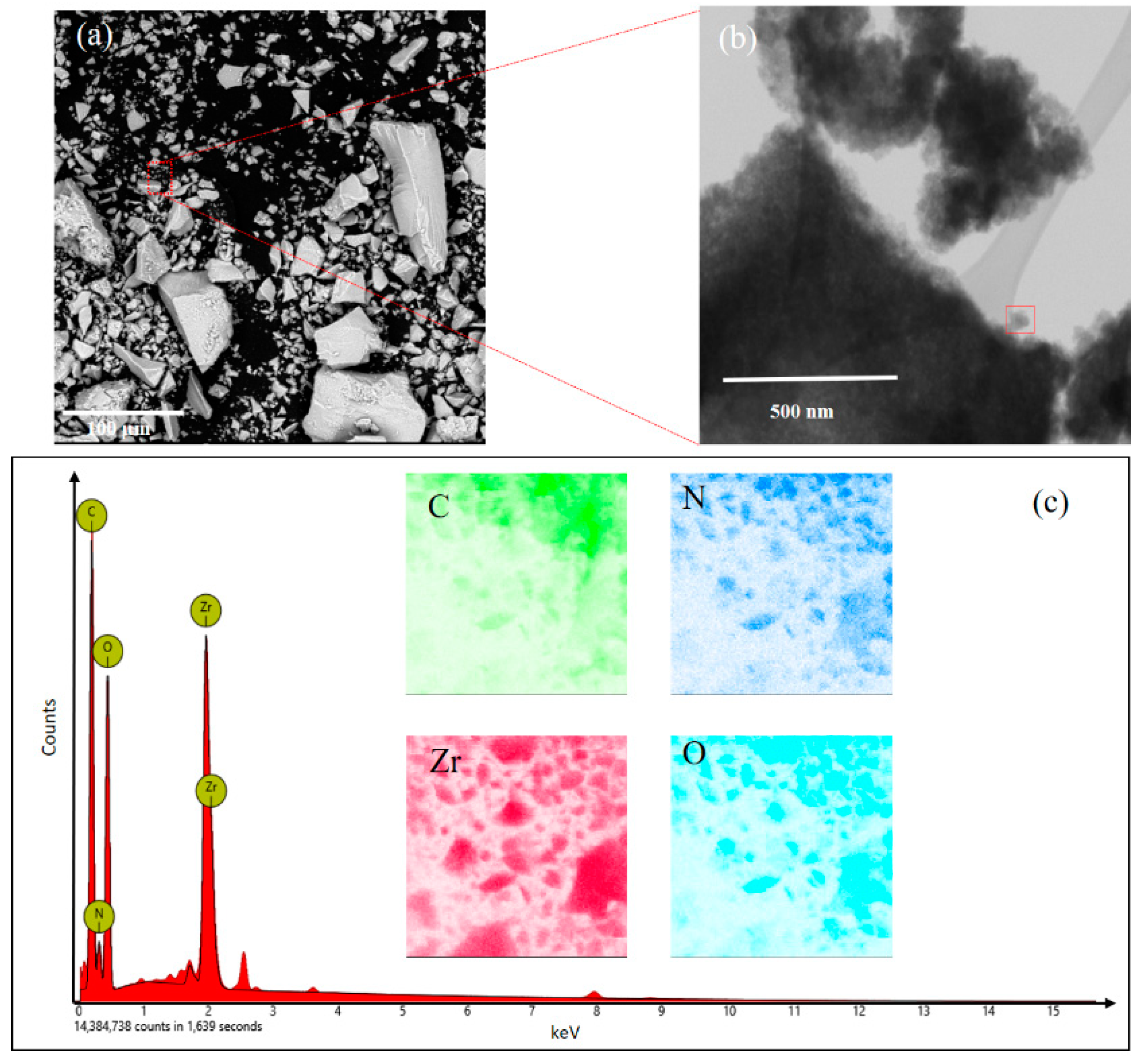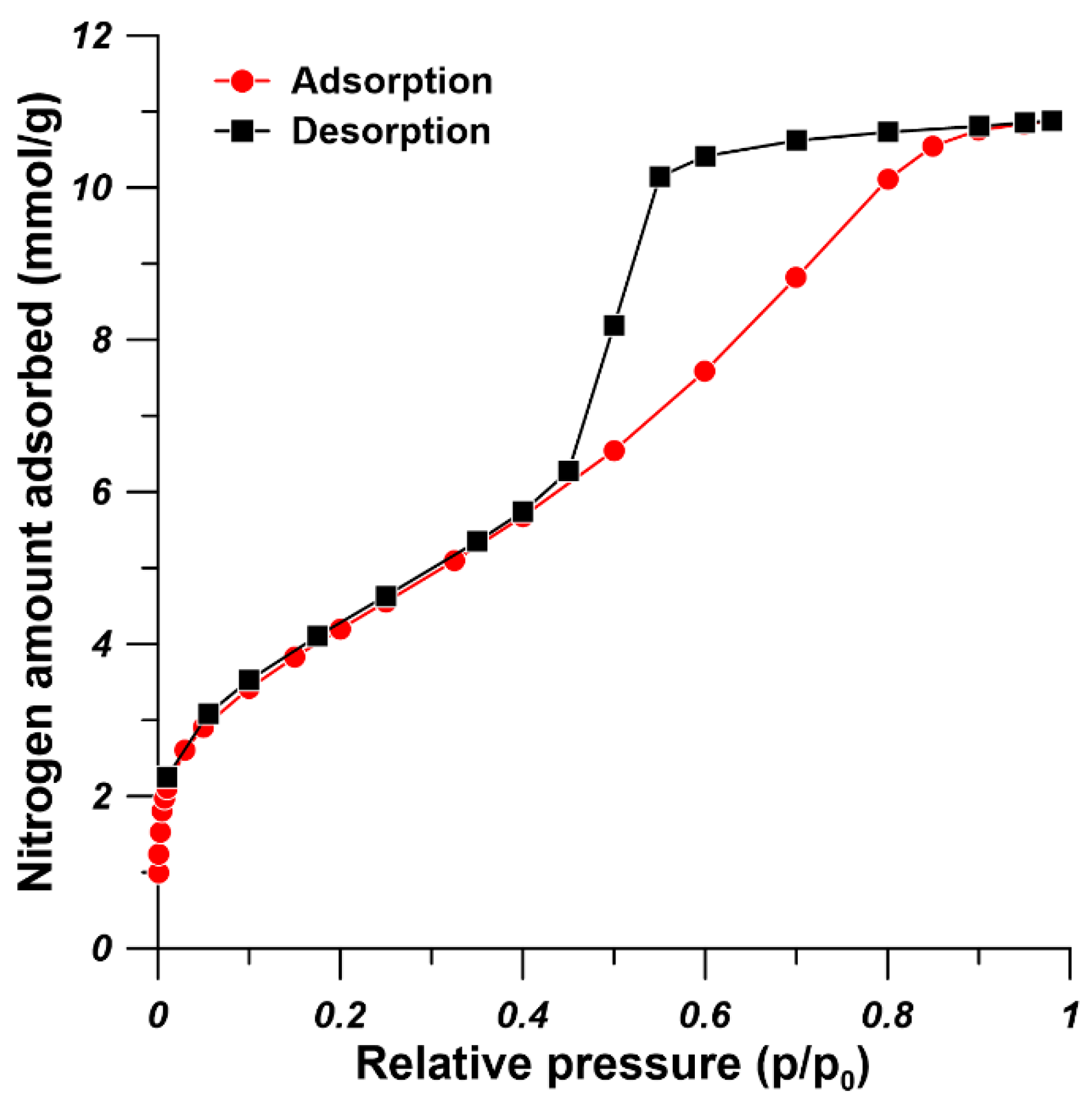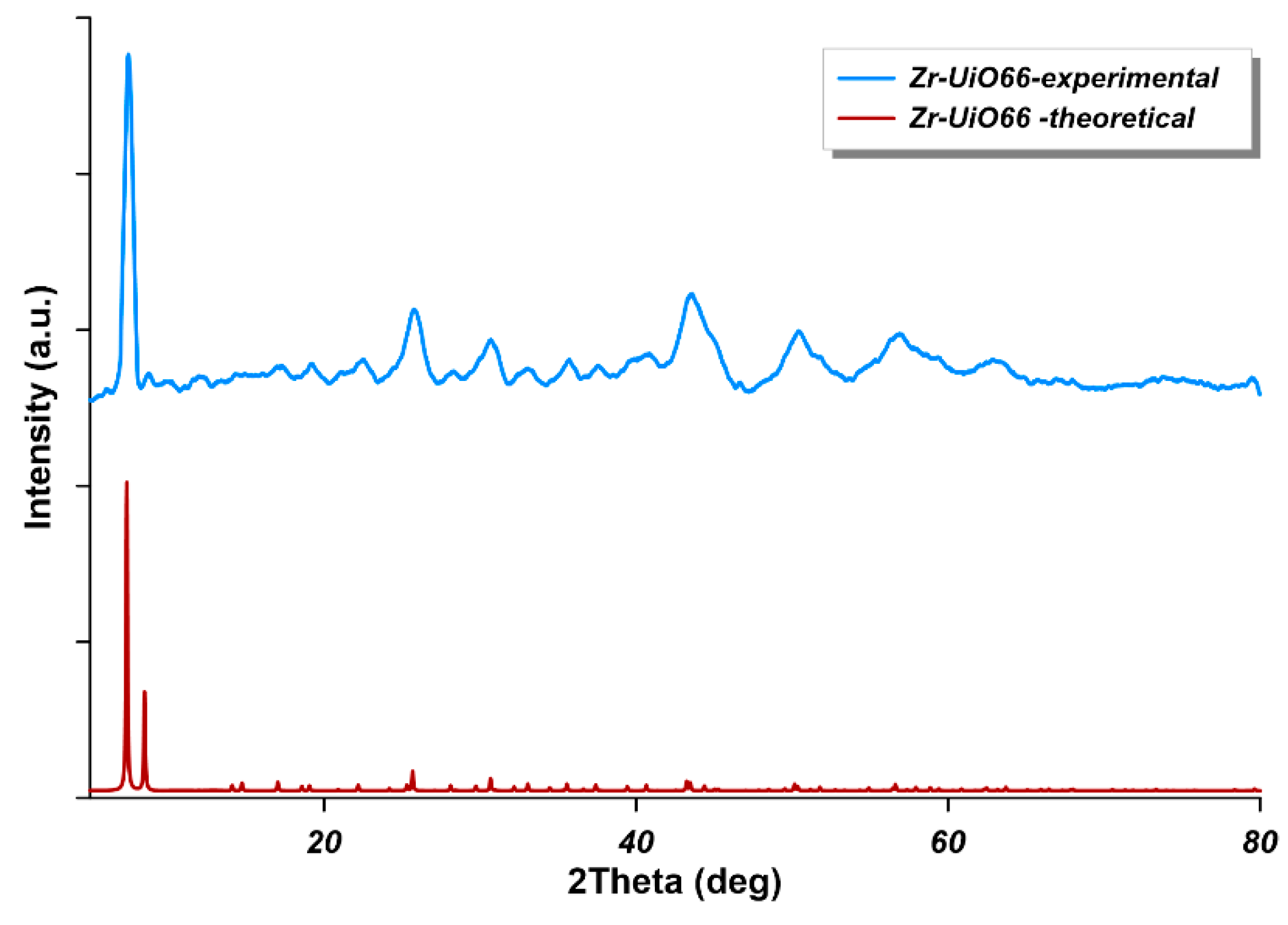Thin Film Mixed Matrix Hollow Fiber Membrane Fabricated by Incorporation of Amine Functionalized Metal-Organic Framework for CO2/N2 Separation
Abstract
1. Introduction
2. Experimental
2.1. Materials
2.2. UiO-66-NH2 Synthesis
2.3. Fabrication of Pristine Pebax/PP and Pebax® 2533-UiO-66-NH2/PP Thin Film Mixed Matrix Hollow Fiber Membranes
2.4. Characterization
2.5. Gas Permeance Measurements
3. Results and Discussion
3.1. Characterization of UiO-66-NH2
3.2. Membrane Characterization
3.3. The Effect of UiO-66-NH2 Loading on Gas Separation Performance
3.4. Comparison of the Pebax®-Based Mixed Matrix Membranes Incorporating Various Nanoparticles in CO2/N2 Gas Separation
4. Conclusions
Supplementary Materials
Author Contributions
Funding
Institutional Review Board Statement
Informed Consent Statement
Data Availability Statement
Conflicts of Interest
References
- Al Mesfer, M.K.; Danish, M. Breakthrough adsorption study of activated carbons for CO2 separation from flue gas. J. Environ. Chem. Eng. 2018, 6, 4514–4524. [Google Scholar] [CrossRef]
- Wang, K.; Xu, H.; Yang, C.; Qiu, T. Machine learning-based ionic liquids design and process simulation for CO2 separation from flue gas. Green Energy Environ. 2020. [Google Scholar] [CrossRef]
- Polat, H.M.; Kavak, S.; Kulak, H.; Uzun, A.; Keskin, S. CO2 separation from flue gas mixture using [BMIM][BF4]/MOF com-posites: Linking high-throughput computational screening with experiments. Chem. Eng. J. 2020, 394, 124916. [Google Scholar] [CrossRef]
- Gilassi, S.; Taghavi, S.M.; Rodrigue, D.; Kaliaguine, S. Techno-Economic Analysis of a Hybrid System for Flue-Gas Separa-tion: Combining Membrane and Enzymatic-Absorption Processes. Chem. Eng. Process. Process. Intensif. 2021, 159, 108222. [Google Scholar] [CrossRef]
- Kamble, A.R.; Patel, C.M.; Murthy, Z. A review on the recent advances in mixed matrix membranes for gas separation processes. Renew. Sustain. Energy Rev. 2021, 145, 111062. [Google Scholar] [CrossRef]
- Li, G.; Kujawski, W.; Válek, R.; Koter, S. A review—The development of hollow fibre membranes for gas separation processes. Int. J. Greenh. Gas. Control. 2021, 104, 103195. [Google Scholar] [CrossRef]
- Li, G.; Kujawski, W.; Knozowska, K.; Kujawa, J. The Effects of PEI Hollow Fiber Substrate Characteristics on PDMS/PEI Hollow Fiber Membranes for CO2/N2 Separation. Membranes 2021, 11, 56. [Google Scholar] [CrossRef]
- Li, G.; Knozowska, K.; Kujawa, J.; Tonkonogovas, A.; Stankevičius, A.; Kujawski, W. Fabrication of Polydimethysiloxane (PDMS) Dense Layer on Polyetherimide (PEI) Hollow Fiber Support for the Efficient CO2/N2 Separation Membranes. Polymers 2021, 13, 756. [Google Scholar] [CrossRef] [PubMed]
- Liu, B.; Tang, C.; Li, X.; Wang, B.; Zhou, R. High-performance SAPO-34 membranes for CO2 separations from simulated flue gas. Microporous Mesoporous Mater. 2020, 292, 109712. [Google Scholar] [CrossRef]
- Ilicak, I.; Boroglu, M.S.; Durmus, A.; Boz, I. Influence of ZIF-95 on structure and gas separation properties of polyi-mide-based mixed matrix membranes. J. Nat. Gas. Sci. Eng. 2021, 91, 103941. [Google Scholar] [CrossRef]
- Wang, Q.; Dai, Y.; Ruan, X.; Zheng, W.; Yan, X.; Li, X.; He, G. ZIF-8 hollow nanotubes based mixed matrix membranes with high-speed gas transmission channel to promote CO2/N2 separation. J. Membr. Sci. 2021, 630, 119323. [Google Scholar] [CrossRef]
- Saqib, S.; Rafiq, S.; Muhammad, N.; Khan, A.L.; Mukhtar, A.; Ullah, S.; Nawaz, M.H.; Jamil, F.; Zhang, C.; Ashokkumar, V. Sustainable mixed matrix membranes containing porphyrin and polysulfone polymer for acid gas separations. J. Hazard. Mater. 2021, 411, 125155. [Google Scholar] [CrossRef]
- Liu, L.; Chakma, A.; Feng, X. CO2/N2 Separation by Poly(Ether Block Amide) Thin Film Hollow Fiber Composite Membranes. Ind. Eng. Chem. Res. 2005, 44, 6874–6882. [Google Scholar] [CrossRef]
- Shen, J.; Liu, G.; Huang, K.; Li, Q.; Guan, K.; Li, Y.; Jin, W. UiO-66-polyether block amide mixed matrix membranes for CO2 separation. J. Membr. Sci. 2016, 513, 155–165. [Google Scholar] [CrossRef]
- Casadei, R.; Baschetti, M.G.; Yoo, M.J.; Park, H.B.; Giorgini, L. Pebax® 2533/Graphene Oxide Nanocomposite Membranes for Carbon Capture. Membranes 2020, 10, 188. [Google Scholar] [CrossRef] [PubMed]
- Liu, C.; Wang, J.; Wan, J.; Yu, C. MOF-on-MOF hybrids: Synthesis and applications. Co-Ord. Chem. Rev. 2021, 432, 213743. [Google Scholar] [CrossRef]
- Chen, S.; Li, X.; Duan, J.; Fu, Y.; Wang, Z.; Zhu, M.; Li, N. Investigation of highly efficient adsorbent based on Ni-MOF-74 in the separation of CO2 from natural gas. Chem. Eng. J. 2021, 419, 129653. [Google Scholar] [CrossRef]
- Kujawa, J.; Al-Gharabli, S.; Muzioł, T.M.; Knozowska, K.; Li, G.; Dumée, L.F.; Kujawski, W. Crystalline porous frameworks as nano-enhancers for membrane liquid separation—Recent developments. Co-Ord. Chem. Rev. 2021, 440, 213969. [Google Scholar] [CrossRef]
- Gao, J.; Mao, H.; Jin, H.; Chen, C.; Feldhoff, A.; Li, Y. Functionalized ZIF-7/Pebax® 2533 mixed matrix membranes for CO2/N2 separation. Microporous Mesoporous Mater. 2020, 297, 110030. [Google Scholar] [CrossRef]
- Song, C.; Li, R.; Fan, Z.; Liu, Q.; Zhang, B.; Kitamura, Y. CO2/N2 separation performance of Pebax/MIL-101 and Pebax /NH2-MIL-101 mixed matrix membranes and intensification via sub-ambient operation. Sep. Purif. Technol. 2020, 238, 116500. [Google Scholar] [CrossRef]
- Chuah, C.Y.; Lee, J.; Song, J.; Bae, T.-H. CO2/N2 Separation Properties of Polyimide-Based Mixed-Matrix Membranes Comprising UiO-66 with Various Functionalities. Membranes 2020, 10, 154. [Google Scholar] [CrossRef] [PubMed]
- Jiang, Y.; Liu, C.; Caro, J.; Huang, A. A new UiO-66-NH2 based mixed-matrix membranes with high CO2/CH4 separation performance. Microporous Mesoporous Mater. 2019, 274, 203–211. [Google Scholar] [CrossRef]
- Jameh, A.A.; Mohammadi, T.; Bakhtiari, O. Preparation of PEBAX-1074/modified ZIF-8 nanoparticles mixed matrix membranes for CO2 removal from natural gas. Sep. Purif. Technol. 2020, 231, 115900. [Google Scholar] [CrossRef]
- Dai, Y.; Johnson, J.; Karvan, O.; Sholl, D.S.; Koros, W. Ultem®/ZIF-8 mixed matrix hollow fiber membranes for CO2/N2 separations. J. Membr. Sci. 2012, 401–402, 76–82. [Google Scholar] [CrossRef]
- Etxeberria-Benavides, M.; Johnson, T.; Cao, S.; Zornoza, B.; Coronas, J.; Sanchez-Lainez, J.; Sabetghadam, A.; Liu, X.; Andres-Garcia, E.; Kapteijn, F.; et al. PBI mixed matrix hollow fiber membrane: Influence of ZIF-8 filler over H2/CO2 separation performance at high temperature and pressure. Sep. Purif. Technol. 2020, 237, 116347. [Google Scholar] [CrossRef]
- Xu, Z.-K.; Dai, Q.-W.; Liu, Z.-M.; Kou, R.-Q.; Xu, Y.-Y. Microporous polypropylene hollow fiber membranes: Part II. Per-vaporation separation of water/ethanol mixtures by the poly (acrylic acid) grafted membranes. J. Membr. Sci. 2003, 214, 71–81. [Google Scholar] [CrossRef]
- Szwast, M.; Zalewski, M.; Prokopowicz, L.; Khoshgrudi, R.N. Novel Mixed Matrix Membrane for gas mixture separation. In Monographs of the Environmental Engineering Committee Polish Academy of Sciences: Membranes and Membrane Processes in Environmental Protection; Konieczny, K., Korus, I., Eds.; Polska Akademia Nauk, Komitet Inżynierii Środowiska: Warsaw, Poland, 2014; pp. 89–99. [Google Scholar]
- Zhu, J.; Wu, L.; Bu, Z.; Jie, S.; Li, B.-G. Polyethyleneimine-Modified UiO-66-NH2(Zr) Metal–Organic Frameworks: Preparation and Enhanced CO2 Selective Adsorption. ACS Omega 2009, 4, 3188–3197. [Google Scholar] [CrossRef]
- Hou, J.; Luan, Y.; Tang, J.; Wensley, A.M.; Yang, M.; Lu, Y. Synthesis of UiO-66-NH2 derived heterogeneous copper (II) catalyst and study of its application in the selective aerobic oxidation of alcohols. J. Mol. Catal. A Chem. 2015, 407, 53–59. [Google Scholar] [CrossRef]
- Zhang, X.; Zhang, Y.; Wang, T.; Fan, Z.; Zhang, G. A thin film nanocomposite membrane with pre-immobilized UiO-66-NH2 toward enhanced nanofiltration performance. RSC Adv. 2019, 9, 24802–24810. [Google Scholar] [CrossRef]
- Cao, Y.; Zhang, H.; Song, F.; Huang, T.; Ji, J.; Zhong, Q.; Chu, W.; Xu, Q. UiO-66-NH2/GO Composite: Synthesis, Characterization and CO2 Adsorption Performance. Materials 2018, 11, 589. [Google Scholar] [CrossRef]
- Thommes, M.; Kaneko, K.; Neimark, A.V.; Olivier, J.P.; Rodriguez-Reinoso, F.; Rouquerol, J.; Sing, K.S.W. Physisorption of gases, with special reference to the evaluation of surface area and pore size distribution (IUPAC Technical Report). Pure Appl. Chem. 2015, 87, 1051–1069. [Google Scholar] [CrossRef]
- Sutrisna, P.D.; Hou, J.; Zulkifli, M.Y.; Li, H.; Zhang, Y.; Liang, W.; D’Alessandro, D.M.; Chen, V. Surface functionalized UiO-66/Pebax-based ultrathin composite hollow fiber gas separation membranes. J. Mater. Chem. A 2017, 6, 918–931. [Google Scholar] [CrossRef]
- Tambat, S.N.; Sane, P.K.; Suresh, S.; Varadan, N.; Pandit, A.B.; Sontakke, S.M. Hydrothermal synthesis of NH2-UiO-66 and its application for adsorptive removal of dye. Adv. Powder Technol. 2018, 29, 2626–2632. [Google Scholar] [CrossRef]
- Trickett, C.A.; Gagnon, K.J.; Lee, S.; Gándara, F.; Bürgi, H.-B.; Yaghi, O.M. Definitive Molecular Level Characterization of Defects in UiO-66 Crystals. Angew. Chem. Int. Ed. 2015, 54, 11162–11167. [Google Scholar] [CrossRef] [PubMed]
- Bi, X.; Zhang, Y.; Zhang, F.; Zhang, S.; Wang, Z.; Jin, J. MOF Nanosheet-Based Mixed Matrix Membranes with Metal–Organic Coordination Interfacial Interaction for Gas Separation. ACS Appl. Mater. Interfaces 2020, 12, 49101–49110. [Google Scholar] [CrossRef]
- Gopanna, A.; Mandapati, R.N.; Thomas, S.P.; Rajan, K.; Chavali, M. Fourier transform infrared spectroscopy (FTIR), Raman spectroscopy and wide-angle X-ray scattering (WAXS) of polypropylene (PP)/cyclic olefin copolymer (COC) blends for qualitative and quantitative analysis. Polym. Bull. 2019, 76, 4259–4274. [Google Scholar] [CrossRef]
- Gonzalez-Canche, N.G.; Flores-Johnson, E.A.; Cortes, P.; Carrillo, J.G. Evaluation of surface treatments on 5052-H32 aluminum alloy for enhancing the interfacial adhesion of thermoplastic-based fiber metal laminates. Int. J. Adhes. Adhes. 2018, 82, 90–99. [Google Scholar] [CrossRef]
- Bernardo, P.; Clarizia, G. Enhancing Gas Permeation Properties of Pebax® 1657 Membranes via Polysorbate Nonionic Surfactants Doping. Polymers 2020, 12, 253. [Google Scholar] [CrossRef] [PubMed]
- Sutrisna, P.D.; Hou, J.; Li, H.; Zhang, Y.; Chen, V. Improved operational stability of Pebax-based gas separation membranes with ZIF-8: A comparative study of flat sheet and composite hollow fibre membranes. J. Membr. Sci. 2017, 524, 266–279. [Google Scholar] [CrossRef]
- Nafisi, V.; Hägg, M.-B. Development of dual layer of ZIF-8/PEBAX-2533 mixed matrix membrane for CO2 capture. J. Membr. Sci. 2014, 459, 244–255. [Google Scholar] [CrossRef]
- Biswas, S.P.; Van Der Voort, P. A General Strategy for the Synthesis of Functionalised UiO-66 Frameworks: Characterisation, Stability and CO2 Adsorption Properties. Eur. J. Inorg. Chem. 2013, 2013, 2154–2160. [Google Scholar] [CrossRef]
- Jiao, C.; Li, Z.; Li, X.; Wu, M.; Jiang, H. Improved CO2/N2 separation performance of Pebax composite membrane containing polyethyleneimine functionalized ZIF-8. Sep. Purif. Technol. 2021, 259, 118190. [Google Scholar] [CrossRef]
- Li, Y.; Wang, S.; Wu, H.; Wang, J.; Jiang, Z. Bioadhesion-inspired polymer–inorganic nanohybrid membranes with enhanced CO2 capture properties. J. Mater. Chem. 2012, 22, 19617–19620. [Google Scholar] [CrossRef]
- Li, T.; Pan, Y.; Peinemann, K.-V.; Lai, Z. Carbon dioxide selective mixed matrix composite membrane containing ZIF-7 nano-fillers. J. Membr. Sci. 2013, 425-426, 235–242. [Google Scholar] [CrossRef]
- Zhang, Y.; Shen, Q.; Hou, J.; Sutrisna, P.D.; Chen, V. Shear-aligned graphene oxide laminate/Pebax ultrathin composite hollow fiber membranes using a facile dip-coating approach. J. Mater. Chem. A 2017, 5, 7732–7737. [Google Scholar] [CrossRef]
- Roslan, R.A.; Lau, W.J.; Lai, G.S.; Zulhairun, A.K.; Yeong, Y.F.; Ismail, A.F.; Matsuura, T. Impacts of Multilayer Hybrid Coating on PSF Hollow Fiber Membrane for Enhanced Gas Separation. Membranes 2020, 10, 335. [Google Scholar] [CrossRef] [PubMed]
- Zheng, W.; Ding, R.; Yang, K.; Dai, Y.; Yan, X.; He, G. ZIF-8 nanoparticles with tunable size for enhanced CO2 capture of Pebax based MMMs. Sep. Purif. Technol. 2019, 214, 111–119. [Google Scholar] [CrossRef]
- Meshkat, S.; Kaliaguine, S.; Rodrigue, D. Mixed matrix membranes based on amine and non-amine MIL-53(Al) in Pebax® MH-1657 for CO2 separation. Sep. Purif. Technol. 2018, 200, 177–190. [Google Scholar] [CrossRef]
- Zheng, Y.; Wu, Y.; Zhang, B.; Wang, Z. Preparation and characterization of CO2-selective Pebax/NaY mixed matrix membranes. J. Appl. Polym. Sci. 2020, 137, 48398. [Google Scholar] [CrossRef]
- Dong, L.; Chen, M.; Li, J.; Shi, D.; Dong, W.; Li, X.; Bai, Y. Metal-organic framework-graphene oxide composites: A facile method to highly improve the CO2 separation performance of mixed matrix membranes. J. Membr. Sci. 2016, 520, 801–811. [Google Scholar] [CrossRef]
- Zhang, X.; Zhang, T.; Wang, Y.; Li, J.; Liu, C.; Li, N.; Liao, J. Mixed-matrix membranes based on Zn/Ni-ZIF-8-PEBA for high performance CO2 separation. J. Membr. Sci. 2018, 560, 38–46. [Google Scholar] [CrossRef]









| Support Polymer | Hybrid Coating Material | Filler Content (wt%) | Configuration | Feed Gas | CO2 (GPU) | N2 (GPU) | CO2/N2 Selectivity | Ref. |
|---|---|---|---|---|---|---|---|---|
| PVDF/PTMSP | UiO-66-NH2/Pebax® 1657 | 50 | Hollow fiber | Pure gas | 338 | 5.93 | 57 | [33] |
| PSF | Fe(DA)/Pebax® 1657 | 3 | Hollow fiber | Pure gas | 90.00 | 1.61 | 56 | [44] |
| PVDF | ZIF-8/Pebax® 1657 | 30 | Hollow fiber | Pure gas | 350.00 | 10.94 | 32 | [40] |
| PVDF | GO/Pebax® 1657 | 0.1 | Hollow fiber | Pure gas | 415.00 | 9.65 | 43 | [46] |
| PSF | GO/Pebax® 1657 | 0.4 | Hollow fiber | Pure gas | 28.08 | 0.66 | 43 | [47] |
| PAN | ZIF-7/Pebax® 1657 | 34 | Flat sheet | Pure gas | 39.00 | 0.37 | 105 | [45] |
| PVDF | UiO-66-NH2/Pebax® 1657 | 20 | Flat sheet | Pure gas | 125 Barrer | - | 25 | [14] |
| - | ZIF-8/Pebax® 1657 | 20 | Dense flat sheet | Pure gas | 2.80 | 0.07 | 41 | [48] |
| - | NH2-MIL-53/Pebax® 1657 | 10 | Dense flat sheet | Pure gas | 1.60 | 0.03 | 55 | [49] |
| - | NaY/Pebax® 1657 | 10 | Dense flat sheet | Pure gas | 3.60 | 0.10 | 35 | [50] |
| - | ZIF-7/Pebax® 2533 | 14 | Dense flat sheet | Pure gas | 198 Barrer | 8.74 Barrer | 22.6 | [19] |
| - | ZIF-7-NH2/Pebax® 2533 | 14 | Dense flat sheet | Pure gas | 206 Barrer | 7.53 Barrer | 27.3 | [19] |
| - | ZIF-8@GO/Pebax® 2533 | 6 | Dense flat sheet | Pure gas | 249 Barrer | 5.23 Barrer | 47.6 | [51] |
| - | Zn/Ni-ZIF-8/Pebax® 2533 | 10 | Dense flat sheet | Pure gas | 321 Barrer | 7.5 Barrer | 42.8 | [52] |
| PP | UiO-66-NH2/Pebax® 2533 | 10 | Hollow fiber | Pure gas | 25.81 | 0.69 | 37 | This work |
Publisher’s Note: MDPI stays neutral with regard to jurisdictional claims in published maps and institutional affiliations. |
© 2021 by the authors. Licensee MDPI, Basel, Switzerland. This article is an open access article distributed under the terms and conditions of the Creative Commons Attribution (CC BY) license (https://creativecommons.org/licenses/by/4.0/).
Share and Cite
Li, G.; Kujawski, W.; Knozowska, K.; Kujawa, J. Thin Film Mixed Matrix Hollow Fiber Membrane Fabricated by Incorporation of Amine Functionalized Metal-Organic Framework for CO2/N2 Separation. Materials 2021, 14, 3366. https://doi.org/10.3390/ma14123366
Li G, Kujawski W, Knozowska K, Kujawa J. Thin Film Mixed Matrix Hollow Fiber Membrane Fabricated by Incorporation of Amine Functionalized Metal-Organic Framework for CO2/N2 Separation. Materials. 2021; 14(12):3366. https://doi.org/10.3390/ma14123366
Chicago/Turabian StyleLi, Guoqiang, Wojciech Kujawski, Katarzyna Knozowska, and Joanna Kujawa. 2021. "Thin Film Mixed Matrix Hollow Fiber Membrane Fabricated by Incorporation of Amine Functionalized Metal-Organic Framework for CO2/N2 Separation" Materials 14, no. 12: 3366. https://doi.org/10.3390/ma14123366
APA StyleLi, G., Kujawski, W., Knozowska, K., & Kujawa, J. (2021). Thin Film Mixed Matrix Hollow Fiber Membrane Fabricated by Incorporation of Amine Functionalized Metal-Organic Framework for CO2/N2 Separation. Materials, 14(12), 3366. https://doi.org/10.3390/ma14123366








